Accounting Cycle: Concepts, Steps, Worksheet Evaluation & Importance
VerifiedAdded on 2023/06/11
|10
|989
|485
Essay
AI Summary
This essay provides a comprehensive overview of the accounting cycle, detailing each of the nine steps from identifying and analyzing business transactions to revising the books of accounts. It emphasizes the importance of accurate recording and analysis of financial events for a corporate entity. The d...
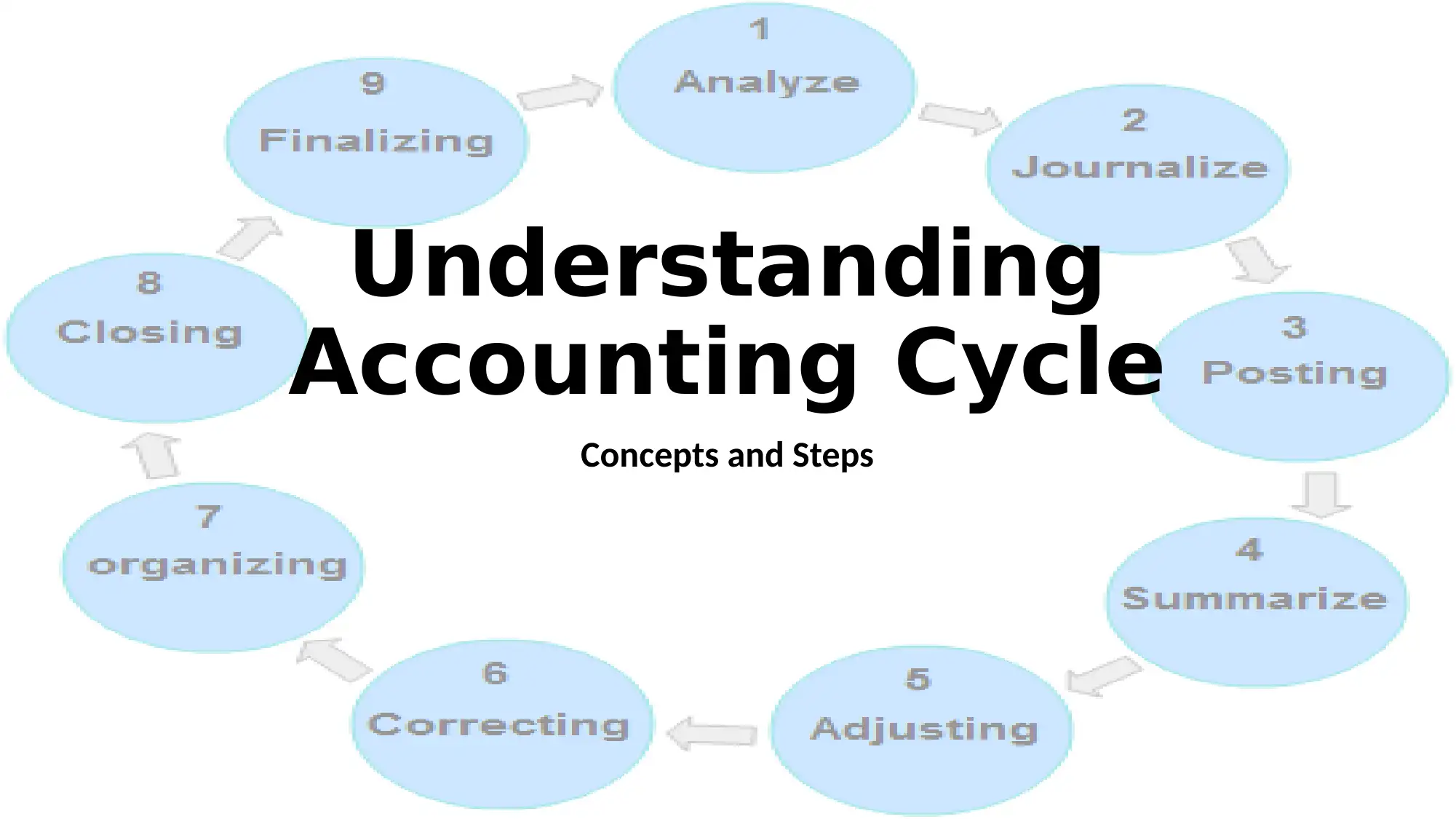
Understanding
Accounting Cycle
Concepts and Steps
Accounting Cycle
Concepts and Steps
Paraphrase This Document
Need a fresh take? Get an instant paraphrase of this document with our AI Paraphraser
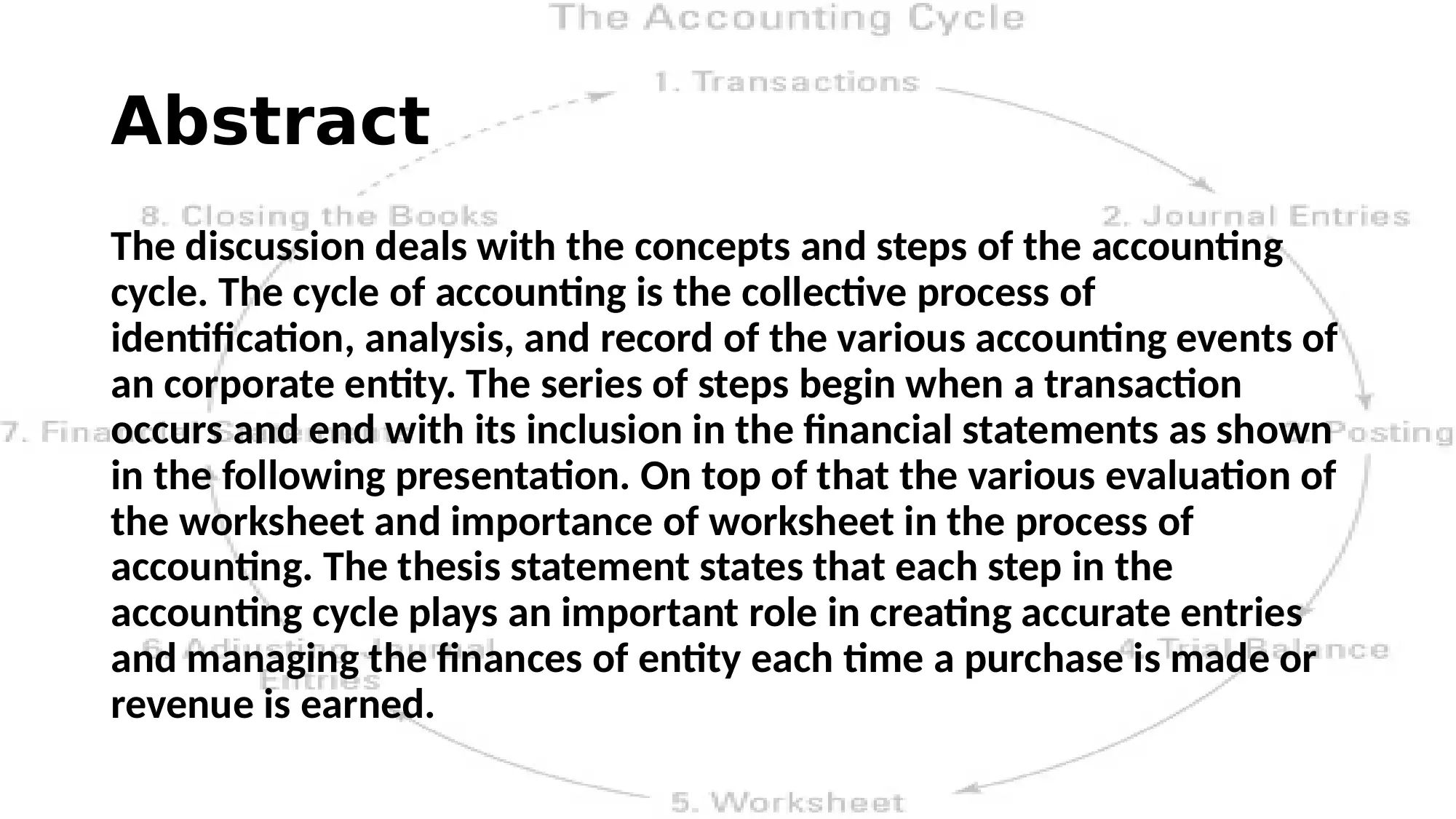
Abstract
The discussion deals with the concepts and steps of the accounting
cycle. The cycle of accounting is the collective process of
identification, analysis, and record of the various accounting events of
an corporate entity. The series of steps begin when a transaction
occurs and end with its inclusion in the financial statements as shown
in the following presentation. On top of that the various evaluation of
the worksheet and importance of worksheet in the process of
accounting. The thesis statement states that each step in the
accounting cycle plays an important role in creating accurate entries
and managing the finances of entity each time a purchase is made or
revenue is earned.
The discussion deals with the concepts and steps of the accounting
cycle. The cycle of accounting is the collective process of
identification, analysis, and record of the various accounting events of
an corporate entity. The series of steps begin when a transaction
occurs and end with its inclusion in the financial statements as shown
in the following presentation. On top of that the various evaluation of
the worksheet and importance of worksheet in the process of
accounting. The thesis statement states that each step in the
accounting cycle plays an important role in creating accurate entries
and managing the finances of entity each time a purchase is made or
revenue is earned.
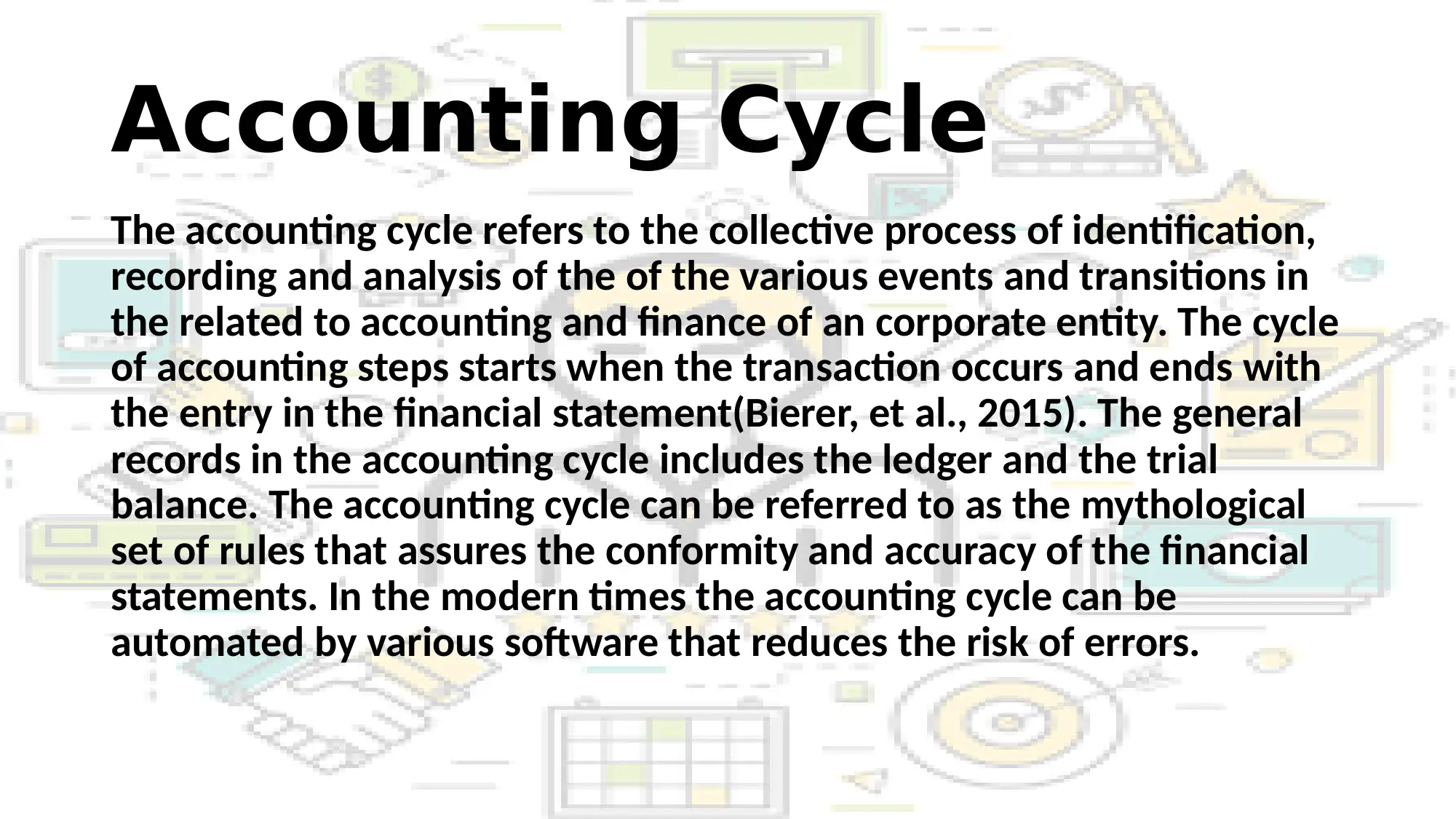
Accounting Cycle
The accounting cycle refers to the collective process of identification,
recording and analysis of the of the various events and transitions in
the related to accounting and finance of an corporate entity. The cycle
of accounting steps starts when the transaction occurs and ends with
the entry in the financial statement(Bierer, et al., 2015). The general
records in the accounting cycle includes the ledger and the trial
balance. The accounting cycle can be referred to as the mythological
set of rules that assures the conformity and accuracy of the financial
statements. In the modern times the accounting cycle can be
automated by various software that reduces the risk of errors.
The accounting cycle refers to the collective process of identification,
recording and analysis of the of the various events and transitions in
the related to accounting and finance of an corporate entity. The cycle
of accounting steps starts when the transaction occurs and ends with
the entry in the financial statement(Bierer, et al., 2015). The general
records in the accounting cycle includes the ledger and the trial
balance. The accounting cycle can be referred to as the mythological
set of rules that assures the conformity and accuracy of the financial
statements. In the modern times the accounting cycle can be
automated by various software that reduces the risk of errors.
⊘ This is a preview!⊘
Do you want full access?
Subscribe today to unlock all pages.

Trusted by 1+ million students worldwide
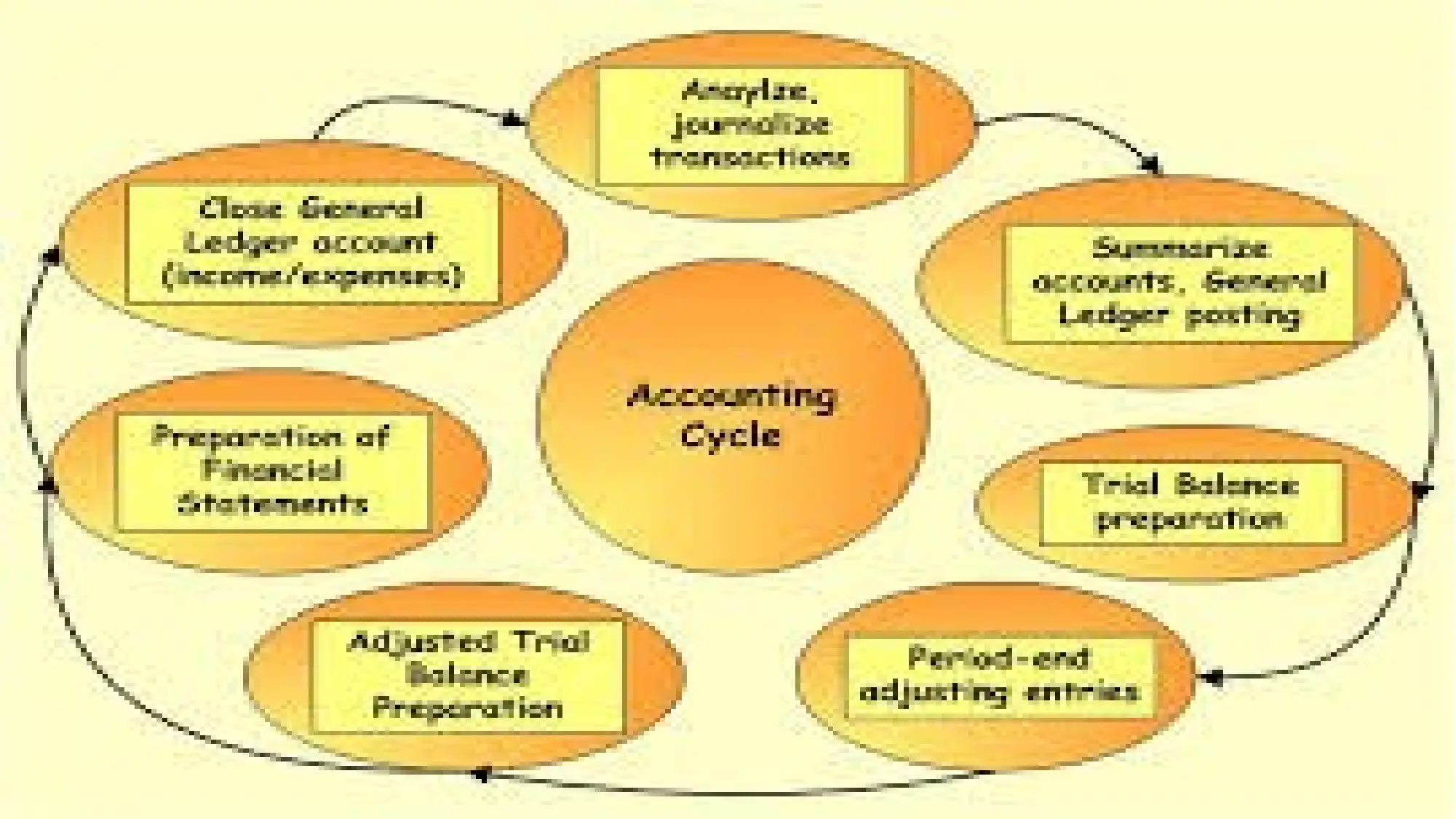
Paraphrase This Document
Need a fresh take? Get an instant paraphrase of this document with our AI Paraphraser
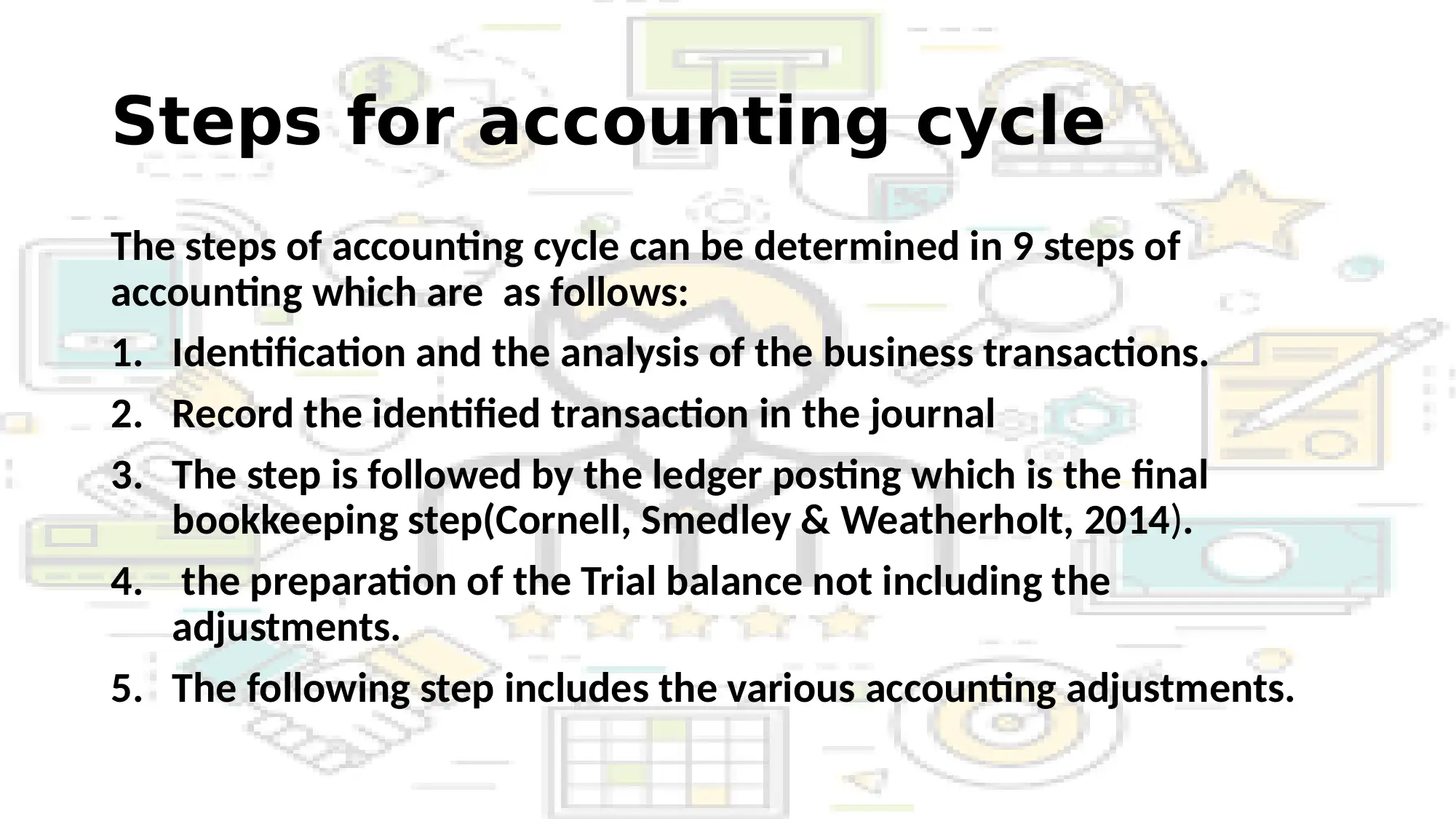
Steps for accounting cycle
The steps of accounting cycle can be determined in 9 steps of
accounting which are as follows:
1. Identification and the analysis of the business transactions.
2. Record the identified transaction in the journal
3. The step is followed by the ledger posting which is the final
bookkeeping step(Cornell, Smedley & Weatherholt, 2014).
4. the preparation of the Trial balance not including the
adjustments.
5. The following step includes the various accounting adjustments.
The steps of accounting cycle can be determined in 9 steps of
accounting which are as follows:
1. Identification and the analysis of the business transactions.
2. Record the identified transaction in the journal
3. The step is followed by the ledger posting which is the final
bookkeeping step(Cornell, Smedley & Weatherholt, 2014).
4. the preparation of the Trial balance not including the
adjustments.
5. The following step includes the various accounting adjustments.
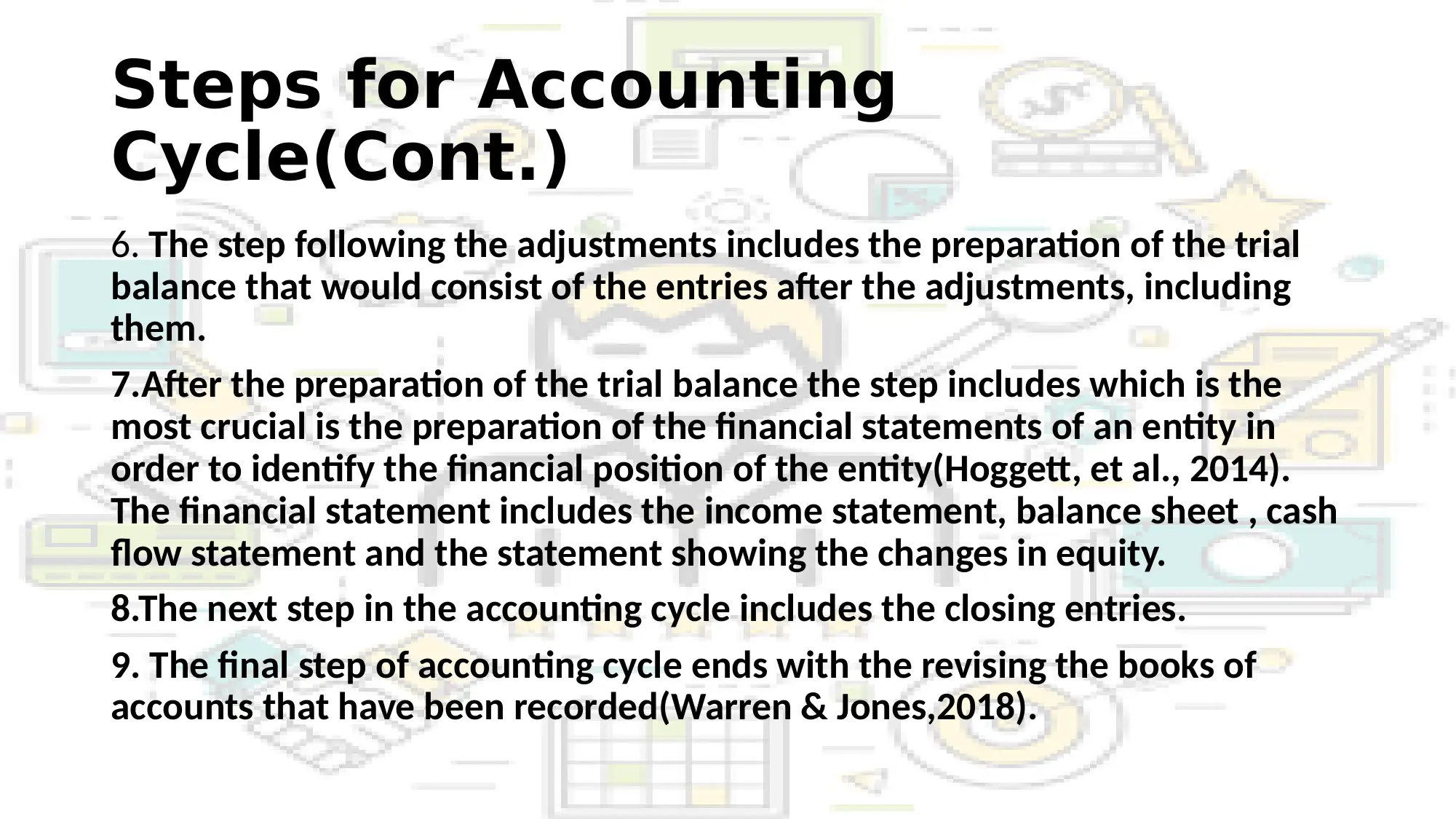
Steps for Accounting
Cycle(Cont.)
6. The step following the adjustments includes the preparation of the trial
balance that would consist of the entries after the adjustments, including
them.
7.After the preparation of the trial balance the step includes which is the
most crucial is the preparation of the financial statements of an entity in
order to identify the financial position of the entity(Hoggett, et al., 2014).
The financial statement includes the income statement, balance sheet , cash
flow statement and the statement showing the changes in equity.
8.The next step in the accounting cycle includes the closing entries.
9. The final step of accounting cycle ends with the revising the books of
accounts that have been recorded(Warren & Jones,2018).
Cycle(Cont.)
6. The step following the adjustments includes the preparation of the trial
balance that would consist of the entries after the adjustments, including
them.
7.After the preparation of the trial balance the step includes which is the
most crucial is the preparation of the financial statements of an entity in
order to identify the financial position of the entity(Hoggett, et al., 2014).
The financial statement includes the income statement, balance sheet , cash
flow statement and the statement showing the changes in equity.
8.The next step in the accounting cycle includes the closing entries.
9. The final step of accounting cycle ends with the revising the books of
accounts that have been recorded(Warren & Jones,2018).
⊘ This is a preview!⊘
Do you want full access?
Subscribe today to unlock all pages.

Trusted by 1+ million students worldwide
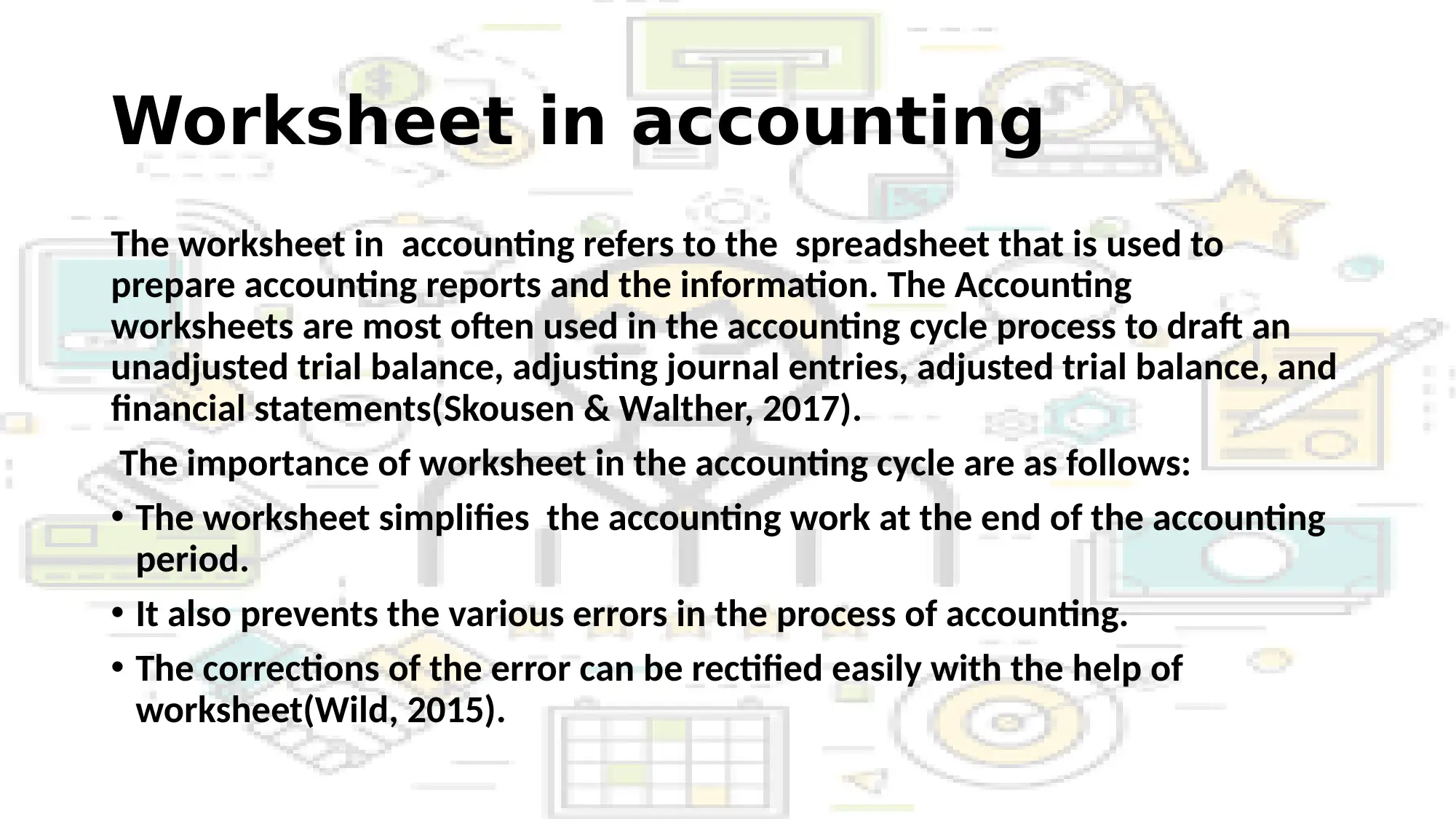
Worksheet in accounting
The worksheet in accounting refers to the spreadsheet that is used to
prepare accounting reports and the information. The Accounting
worksheets are most often used in the accounting cycle process to draft an
unadjusted trial balance, adjusting journal entries, adjusted trial balance, and
financial statements(Skousen & Walther, 2017).
The importance of worksheet in the accounting cycle are as follows:
• The worksheet simplifies the accounting work at the end of the accounting
period.
• It also prevents the various errors in the process of accounting.
• The corrections of the error can be rectified easily with the help of
worksheet(Wild, 2015).
The worksheet in accounting refers to the spreadsheet that is used to
prepare accounting reports and the information. The Accounting
worksheets are most often used in the accounting cycle process to draft an
unadjusted trial balance, adjusting journal entries, adjusted trial balance, and
financial statements(Skousen & Walther, 2017).
The importance of worksheet in the accounting cycle are as follows:
• The worksheet simplifies the accounting work at the end of the accounting
period.
• It also prevents the various errors in the process of accounting.
• The corrections of the error can be rectified easily with the help of
worksheet(Wild, 2015).
Paraphrase This Document
Need a fresh take? Get an instant paraphrase of this document with our AI Paraphraser
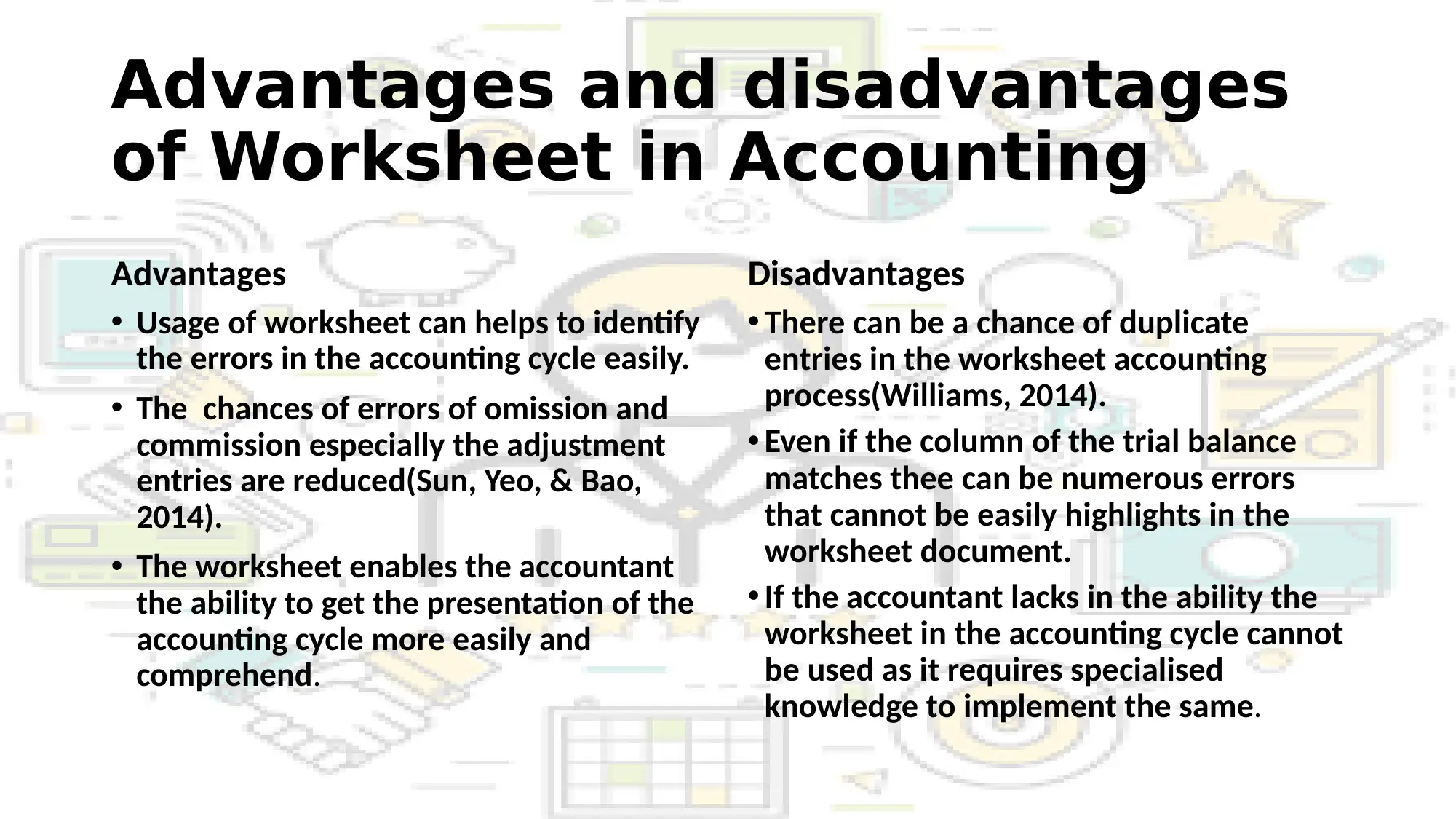
Advantages and disadvantages
of Worksheet in Accounting
Advantages
• Usage of worksheet can helps to identify
the errors in the accounting cycle easily.
• The chances of errors of omission and
commission especially the adjustment
entries are reduced(Sun, Yeo, & Bao,
2014).
• The worksheet enables the accountant
the ability to get the presentation of the
accounting cycle more easily and
comprehend.
Disadvantages
• There can be a chance of duplicate
entries in the worksheet accounting
process(Williams, 2014).
• Even if the column of the trial balance
matches thee can be numerous errors
that cannot be easily highlights in the
worksheet document.
• If the accountant lacks in the ability the
worksheet in the accounting cycle cannot
be used as it requires specialised
knowledge to implement the same.
of Worksheet in Accounting
Advantages
• Usage of worksheet can helps to identify
the errors in the accounting cycle easily.
• The chances of errors of omission and
commission especially the adjustment
entries are reduced(Sun, Yeo, & Bao,
2014).
• The worksheet enables the accountant
the ability to get the presentation of the
accounting cycle more easily and
comprehend.
Disadvantages
• There can be a chance of duplicate
entries in the worksheet accounting
process(Williams, 2014).
• Even if the column of the trial balance
matches thee can be numerous errors
that cannot be easily highlights in the
worksheet document.
• If the accountant lacks in the ability the
worksheet in the accounting cycle cannot
be used as it requires specialised
knowledge to implement the same.
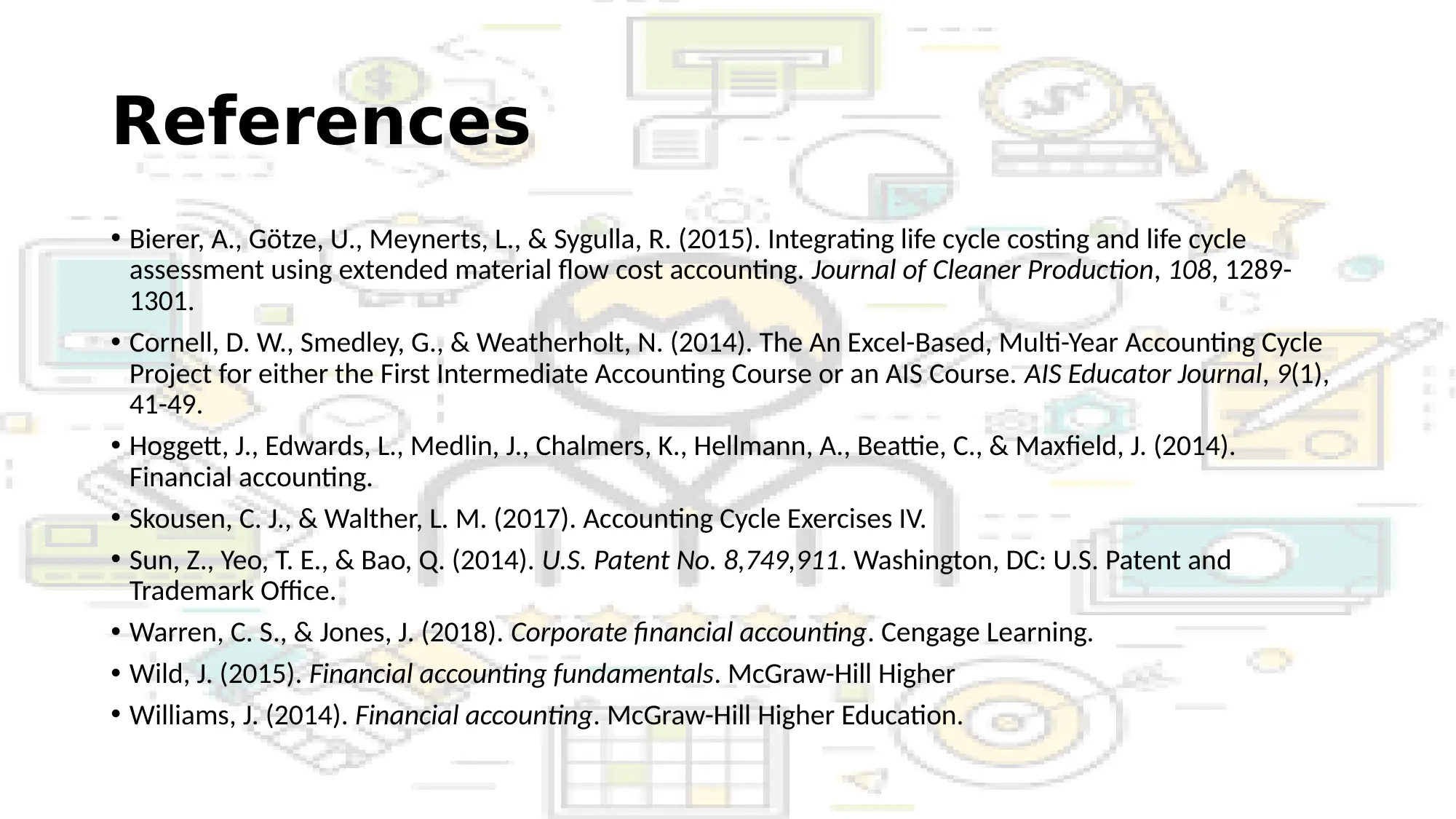
References
• Bierer, A., Götze, U., Meynerts, L., & Sygulla, R. (2015). Integrating life cycle costing and life cycle
assessment using extended material flow cost accounting. Journal of Cleaner Production, 108, 1289-
1301.
• Cornell, D. W., Smedley, G., & Weatherholt, N. (2014). The An Excel-Based, Multi-Year Accounting Cycle
Project for either the First Intermediate Accounting Course or an AIS Course. AIS Educator Journal, 9(1),
41-49.
• Hoggett, J., Edwards, L., Medlin, J., Chalmers, K., Hellmann, A., Beattie, C., & Maxfield, J. (2014).
Financial accounting.
• Skousen, C. J., & Walther, L. M. (2017). Accounting Cycle Exercises IV.
• Sun, Z., Yeo, T. E., & Bao, Q. (2014). U.S. Patent No. 8,749,911. Washington, DC: U.S. Patent and
Trademark Office.
• Warren, C. S., & Jones, J. (2018). Corporate financial accounting. Cengage Learning.
• Wild, J. (2015). Financial accounting fundamentals. McGraw-Hill Higher
• Williams, J. (2014). Financial accounting. McGraw-Hill Higher Education.
• Bierer, A., Götze, U., Meynerts, L., & Sygulla, R. (2015). Integrating life cycle costing and life cycle
assessment using extended material flow cost accounting. Journal of Cleaner Production, 108, 1289-
1301.
• Cornell, D. W., Smedley, G., & Weatherholt, N. (2014). The An Excel-Based, Multi-Year Accounting Cycle
Project for either the First Intermediate Accounting Course or an AIS Course. AIS Educator Journal, 9(1),
41-49.
• Hoggett, J., Edwards, L., Medlin, J., Chalmers, K., Hellmann, A., Beattie, C., & Maxfield, J. (2014).
Financial accounting.
• Skousen, C. J., & Walther, L. M. (2017). Accounting Cycle Exercises IV.
• Sun, Z., Yeo, T. E., & Bao, Q. (2014). U.S. Patent No. 8,749,911. Washington, DC: U.S. Patent and
Trademark Office.
• Warren, C. S., & Jones, J. (2018). Corporate financial accounting. Cengage Learning.
• Wild, J. (2015). Financial accounting fundamentals. McGraw-Hill Higher
• Williams, J. (2014). Financial accounting. McGraw-Hill Higher Education.
⊘ This is a preview!⊘
Do you want full access?
Subscribe today to unlock all pages.

Trusted by 1+ million students worldwide

Thank You
1 out of 10
Related Documents
Your All-in-One AI-Powered Toolkit for Academic Success.
+13062052269
info@desklib.com
Available 24*7 on WhatsApp / Email
![[object Object]](/_next/static/media/star-bottom.7253800d.svg)
Unlock your academic potential
© 2024 | Zucol Services PVT LTD | All rights reserved.





